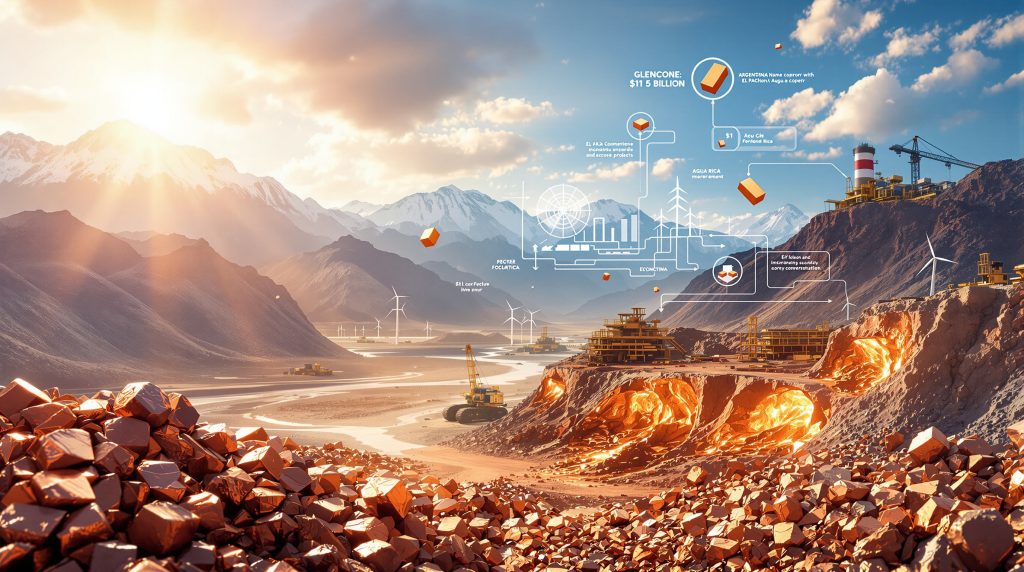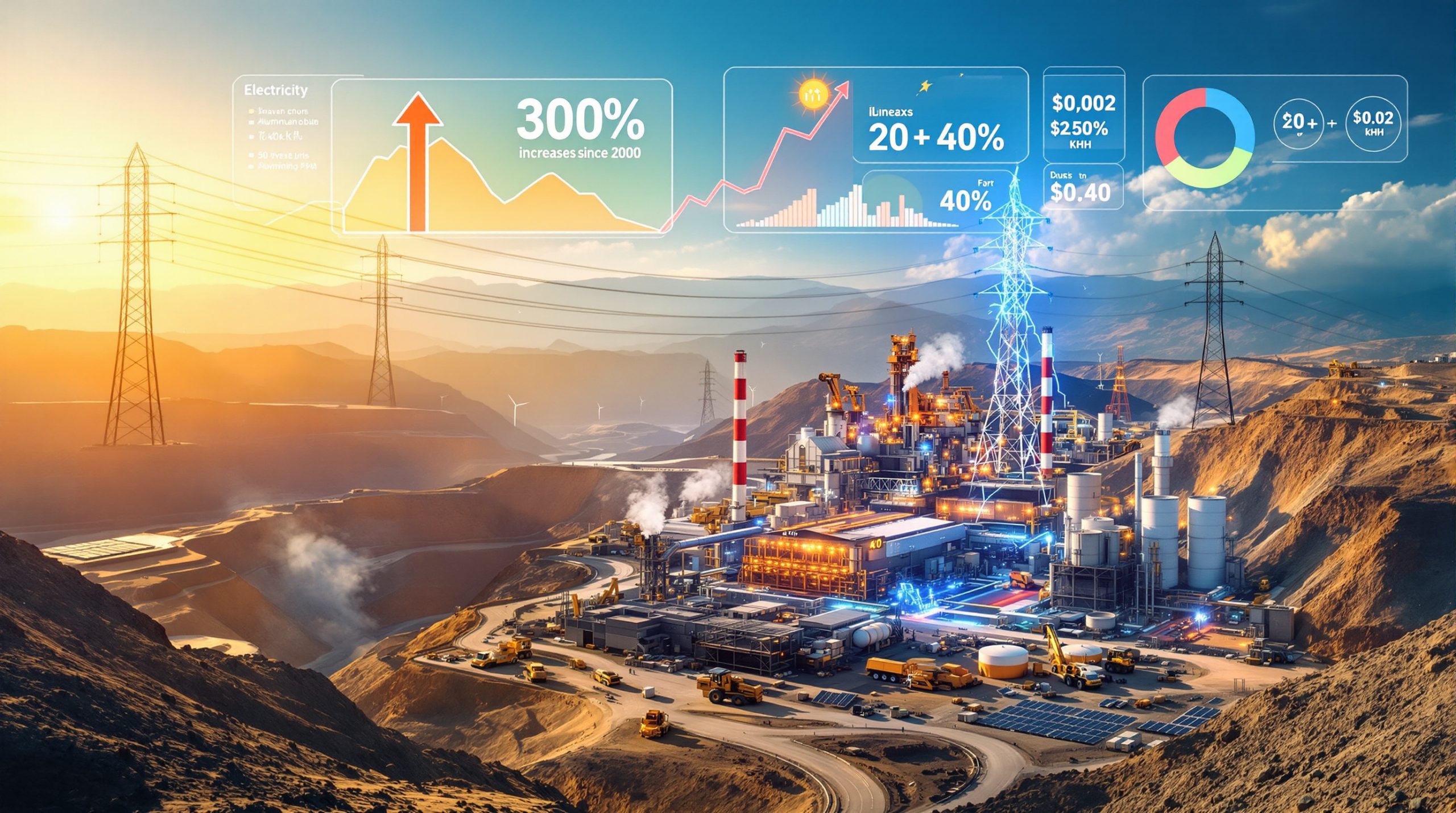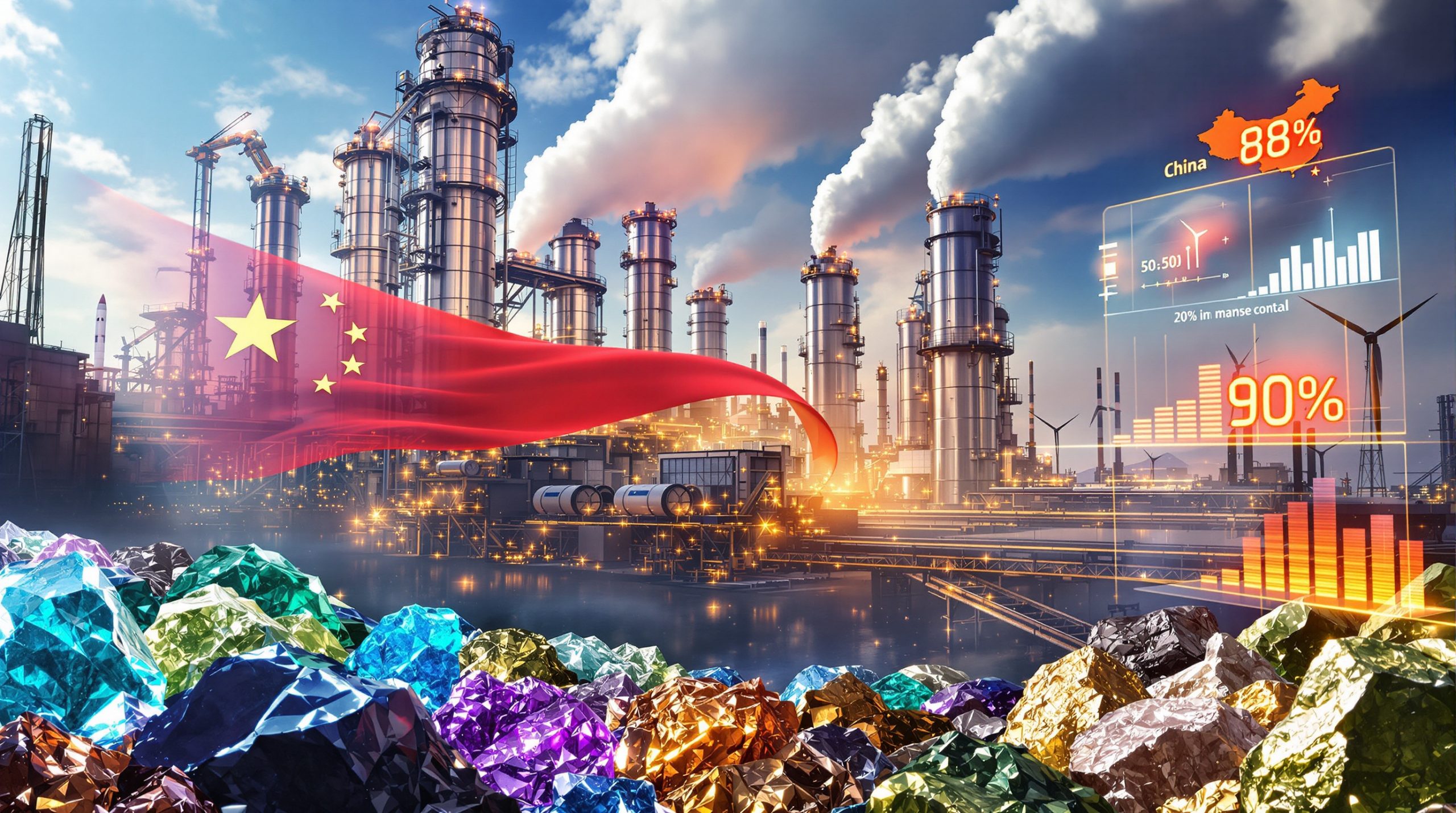Glencore's Bold Copper Play in Argentina: Transforming the Mining Landscape
Glencore is making waves in Argentina's mining sector with two ambitious copper projects that could reshape the country's economic landscape. With investments exceeding $13 billion, El Pachón and Agua Rica represent a significant commitment to copper production in a region eager to attract foreign investment and develop its mineral resources.
These projects come at a critical time when surging copper demand is driven by the worldwide push toward electrification and renewable energy. As copper remains essential for everything from electric vehicles to solar panels, Glencore's strategic investments position the company to capitalize on growing market demand while potentially establishing Argentina as a major player in global copper production.
Glencore's Major Copper Projects in Argentina
Glencore's copper ambitions in Argentina center around two flagship projects: El Pachón and Agua Rica. Together, these ventures represent more than $13 billion in planned investment and have been submitted for inclusion in Argentina's newly established RIGI program, designed to attract and protect foreign investments in the mining sector.
Located in copper-rich regions of the Argentinian Andes, these projects could significantly boost the country's mineral output and export potential. Industry analysts suggest that successful development of these projects could position Argentina as an increasingly important player in global copper markets at a time when demand for the metal is projected to rise substantially.
El Pachón: A World-Class Copper Deposit
El Pachón stands out as one of the most promising undeveloped copper deposits globally. Located in San Juan province near the Chilean border, the project sits in an emerging Argentina copper system that has attracted attention from major mining companies including BHP and Minmetals.
With estimated reserves exceeding 15 million tonnes of copper and a mine life potentially spanning decades, El Pachón could rank among the world's largest copper mines when operational. The deposit features favorable mineralogy with copper grades averaging 0.62%, alongside valuable by-products including molybdenum and silver that enhance its economic potential.
The project benefits from its strategic location in a region developing specialized infrastructure for copper mining operations. Recent road improvements and potential energy corridor developments in San Juan province could provide logistical advantages for the project's development phase and subsequent operations.
Agua Rica: Expanding the Copper Portfolio
Complementing El Pachón in Glencore's Argentina strategy, Agua Rica represents another significant copper opportunity with different geological and operational characteristics. Located in Catamarca province, the project features a copper-gold-molybdenum porphyry deposit with substantial reserves.
Initial feasibility studies indicate the potential for annual production exceeding 100,000 tonnes of copper equivalent over a mine life of approximately 25 years. The project's polymetallic nature, with significant gold credits, provides economic resilience against copper price volatility.
Agua Rica forms a crucial part of Glencore's broader copper investment strategies across South America. The company has invested in detailed geological studies and community engagement programs since acquiring the project, demonstrating long-term commitment to developing this asset as part of its global copper strategy.
How Argentina's RIGI Program Is Transforming Mining Investment
Argentina's Régimen de Incentivo para Grandes Inversiones (RIGI) program represents a fundamental shift in the country's approach to attracting mining investment. Created specifically to provide stability and incentives for large-scale resource development projects, RIGI addresses many of the historical concerns that limited foreign investment in Argentina's mining sector.
Key Benefits of the RIGI Framework
The RIGI program offers multiple advantages designed to mitigate investment risks and enhance project economics for qualified mining ventures:
- Tax stability and incentives: Participating projects receive 30-year tax stability guarantees and progressive reduction in corporate tax rates
- Customs benefits: Reduced or eliminated import duties on capital equipment and technology required for mine development
- Currency protections: Special provisions allowing for greater foreign exchange flexibility and dividend repatriation
- Regulatory certainty: Streamlined permitting processes and protection against regulatory changes
- Provincial coordination: Framework for harmonizing federal and provincial mining regulations
These incentives directly address Argentina's historical challenges of regulatory uncertainty, currency volatility, and complex customs regulations that previously deterred large-scale mining investments.
How RIGI Changes the Investment Landscape
The introduction of RIGI fundamentally alters the risk-reward calculation for mining investments in Argentina. By providing long-term guarantees against Argentina's historically volatile economic and regulatory environment, the program has already generated renewed interest from international mining companies.
"Argentina's RIGI program represents one of the most significant mining policy innovations in Latin America in recent years, potentially positioning the country to compete more effectively against established mining jurisdictions like Chile and Peru," noted a mining industry analyst during a recent sector conference.
The program places Argentina in direct competition with neighboring Chile and Peru for mining investment dollars. Both countries have established mining sectors but face their own challenges, including rising costs, declining ore grades, and evolving regulatory frameworks.
Industry Response to RIGI Implementation
Mining executives, including those from Glencore, have expressed increased confidence in Argentina's investment climate following RIGI's implementation. The program has catalyzed renewed interest in previously stalled projects and prompted mining companies to reassess Argentina's copper potential.
Industry observers note that RIGI's success will ultimately depend on consistent implementation across political transitions—historically a challenge in Argentina. However, the program's establishment as national law provides some insulation from political changes, enhancing investor confidence.
Several major mining companies have submitted projects for RIGI consideration, signaling broad industry support for the framework. This growing interest could accelerate development of Argentina's mining sector, potentially establishing a virtuous cycle of investment, infrastructure development, and industry growth.
The Critical Economic Impact of Copper Development for Argentina
The potential $13+ billion investment in El Pachón and Agua Rica represents one of the largest foreign direct investment opportunities in Argentina's history. The economic implications extend far beyond the mining sector itself, with potential to transform regional economies and boost national prosperity.
Economic Impact of Multi-Billion Dollar Investments
These copper projects promise substantial economic benefits across multiple dimensions:
- Job creation: Construction phases could generate 8,000-10,000 direct jobs, with 2,500-3,000 permanent positions during operations
- Infrastructure development: Road improvements, power transmission expansions, and water management systems that benefit broader communities
- Tax revenue generation: Projected annual tax and royalty payments exceeding $500 million at full production
- Foreign exchange earnings: Potential annual export revenues of $2-3 billion, strengthening Argentina's balance of payments
- Technology transfer: Introduction of advanced mining technologies and operational expertise
The multiplier effect of these investments could generate an additional 2-3 indirect jobs for each direct mining position, creating opportunities in everything from equipment maintenance to catering services.
Regional Development in San Juan Province
San Juan province stands to benefit particularly from the emergence of a copper mining cluster centered around El Pachón and neighboring projects. This concentration of mining activity creates opportunities for supplier ecosystem development and specialized workforce training.
The province has already begun positioning itself as a mining-friendly jurisdiction, investing in roads, power infrastructure, and technical education to support industry growth. Local universities have expanded mining engineering and geology programs, creating pathways for residents to access high-skilled mining careers.
For previously underdeveloped regions within San Juan, these projects represent a rare opportunity for economic diversification and growth. Communities that historically relied on limited agricultural opportunities could develop more robust, diverse economies supported by mining activity.
Argentina's Position in Global Copper Markets
Successful development of these projects could substantially elevate Argentina's role in global copper markets. Currently a minor player in copper production, Argentina could potentially emerge as a top-10 global producer if these and other pipeline projects reach full production.
This transformation comes at a strategically important time as global copper supply forecast projects potential deficits beginning in the mid-2020s, creating favorable market conditions for new producers.
For Argentina, establishing a significant copper industry creates opportunities to capture value from growing clean energy supply chains. The country could position itself as a reliable supplier to manufacturers of electric vehicles, renewable energy equipment, and electrical infrastructure—all of which require substantial copper inputs.
Market Factors Driving Glencore's Copper Investment Strategy
Glencore's substantial investments in Argentine copper projects reflect a calculated response to fundamental shifts in global copper markets. The company's strategy aligns with several powerful market trends that are reshaping demand dynamics and supply constraints.
Rising Global Copper Demand
Copper demand projections show steady growth driven by several converging factors:
- Electrification infrastructure: Modern electrical systems require 2-3 times more copper than traditional infrastructure
- Electric vehicle production: Each electric vehicle uses 2-4 times more copper than conventional vehicles (80-100 kg vs. 20-25 kg)
- Renewable energy deployment: Wind and solar installations require 4-5 times more copper per megawatt than traditional power generation
- Grid modernization: Smart grid technologies and energy storage systems demand significant copper inputs
- Industrial automation: Advanced manufacturing and Industry 4.0 implementations increase copper intensity
Collectively, these trends are expected to drive copper demand growth of 2-3% annually through 2030, with potential acceleration as energy transition efforts intensify globally.
Copper's Essential Role in Energy Transition
Copper's unique properties—particularly its superior electrical conductivity and durability—make it irreplaceable in many energy transition applications. No commercially viable substitutes match copper's performance characteristics in electrical applications, creating inelastic demand as the world pursues decarbonisation.
Some key applications include:
- Electric vehicle systems: Motors, batteries, inverters, charging infrastructure
- Renewable generation: Wind turbine generators, solar connectors and transformers
- Grid infrastructure: Transmission lines, transformers, switchgear
- Energy storage: Battery systems, connection equipment, thermal management
As countries worldwide commit to emissions reduction targets, copper requirements will continue to grow substantially. The International Energy Agency estimates that meeting global climate goals could increase copper demand by 40-50% by 2040.
Supply-Demand Dynamics in Copper Markets
While demand projections show robust growth, the supply side faces significant constraints:
- Declining ore grades: Average copper grades have fallen from 1.6% to 0.7% over the past century
- Limited new discoveries: Few world-class copper discoveries in the past decade despite increased exploration spending
- Development timelines: New copper mines typically require 7-10 years from discovery to production
- Rising development costs: Capital intensity for new copper projects has increased substantially
- Resource nationalism: Growing trends toward higher taxation and state participation in mining projects
These supply constraints create favorable conditions for companies like Glencore that can successfully develop major new copper resources. Industry analysts project potential supply deficits of 4-8 million tonnes annually by 2030 if current development pipelines don't accelerate significantly.
Glencore's Strategic Positioning Among Copper Producers
Glencore's approach to copper development in Argentina represents a distinctive strategy that differentiates the company from other major copper producers. This positioning reflects Glencore's unique business model and approach to resource development.
Competitive Positioning Against BHP and Rio Tinto
Glencore's Argentina focus contrasts with the strategies of other major copper producers:
- Project portfolio approach: While BHP and Rio Tinto primarily expand existing operations, Glencore is pursuing new greenfield developments
- Jurisdictional diversification: Glencore shows greater willingness to operate in emerging mining jurisdictions with higher perceived risk profiles
- Vertical integration: Glencore leverages its trading operations to complement mining activities, creating market advantages
- Cost structure targets: Glencore's projects aim for second-quartile production costs, balancing capital efficiency with operational excellence
- Community engagement: Distinctive approach to social license emphasising early and continuous stakeholder involvement
These strategic differences reflect Glencore's origins as a trading company and its evolution into a major mining operator. The company's willingness to pursue opportunities in Argentina demonstrates higher risk tolerance balanced against potentially significant rewards.
Glencore's Global Copper Portfolio Strategy
The Argentina projects fit within Glencore's broader global copper development pipeline, which includes assets across multiple continents. This geographic diversification helps manage political and operational risks while positioning the company in multiple copper-producing regions.
Glencore maintains a balance between:
- Brownfield expansions at existing operations in established jurisdictions
- Strategic acquisitions of advanced-stage projects from junior developers
- Greenfield development of world-class deposits in emerging mining regions
- Joint ventures with strategic partners to share development risks and costs
The Argentina projects exemplify the company's willingness to make counter-cyclical investments, developing assets during periods when others might hesitate due to market uncertainty or jurisdictional concerns.
Investment Timing and Market Cycle Positioning
Glencore's advancement of the El Pachón and Agua Rica projects demonstrates sophisticated market cycle positioning. By developing these assets now, the company aims to bring new production online during the mid-to-late 2020s—a period when many analysts project significant copper supply deficits.
This approach requires:
- Patient capital deployment: Willingness to invest through market cycles
- Long-term price outlook: Focus on fundamental supply-demand dynamics rather than short-term copper price predictions
- Strategic optionality: Maintaining flexibility to accelerate or pause development based on market conditions
- Regulatory engagement: Working constructively with evolving regulatory frameworks like RIGI
By advancing these projects through feasibility and permitting stages now, Glencore positions itself to make final investment decisions at strategically advantageous times, potentially capturing premium copper prices as new production comes online.
Challenges Facing Glencore's Argentina Projects
Despite the significant potential of El Pachón and Agua Rica, these projects face substantial challenges that will influence development timelines, capital requirements, and ultimate production decisions. Understanding these hurdles is essential for realistically assessing project prospects.
Regulatory and Political Considerations
Argentina's political landscape presents both opportunities and challenges for mining development:
- Historical volatility: Past administrations have taken dramatically different approaches to resource development and foreign investment
- Federal-provincial dynamics: Overlapping and sometimes conflicting jurisdiction between national and provincial authorities
- Policy consistency risk: Potential for regulatory changes with electoral cycles despite RIGI framework protections
- Social license challenges: Growing activism around extractive industries requires sophisticated stakeholder engagement
- Export and currency controls: Despite RIGI provisions, residual concerns about Argentina's history of capital controls
While the RIGI program addresses many of these concerns, investors remain cautious about Argentina's history of policy reversals. Glencore must navigate this complex landscape while maintaining operational flexibility and regulatory compliance.
Technical and Operational Challenges
The physical and logistical realities of these projects present significant technical hurdles:
- Water management: Both projects are located in water-stressed regions, requiring innovative approaches to water conservation and recycling
- Power infrastructure: Limited existing electrical capacity necessitates substantial power infrastructure development
- High-altitude operations: El Pachón's location at over 3,500 meters elevation creates unique operational challenges
- Seasonal access limitations: Harsh winter conditions can restrict construction windows and operational continuity
- Skilled labor availability: Competition for experienced mining professionals in a region with developing mining expertise
Addressing these challenges requires specialized engineering solutions, comprehensive planning, and significant upfront capital investment in supporting infrastructure.
Economic and Financial Hurdles
The financial aspects of these developments present their own set of challenges:
- Capital intensity: Development costs exceeding $13 billion require sophisticated financing strategies
- Cost inflation risk: Mining projects globally have experienced significant capital cost escalation in recent years
- Foreign exchange considerations: Currency volatility affecting both capital and operating costs despite RIGI protections
- Commodity price uncertainty: Long-term copper price assumptions critically impact project economics
- Return threshold requirements: Projects must deliver competitive returns against Glencore's global opportunity portfolio
These financial considerations will ultimately determine whether and when Glencore proceeds with full construction of these projects. The company must balance substantial upfront investments against uncertain but potentially significant long-term returns.
Environmental and Social Impact Considerations
Successful development of large-scale mining projects increasingly depends on sophisticated environmental management and genuine community engagement. Glencore's approach to these dimensions will significantly influence project timelines and social acceptance.
Environmental Management Strategies
Modern copper mining requires comprehensive environmental solutions, particularly in environmentally sensitive areas:
- Water conservation technologies: Closed-loop water recycling systems achieving 80-85% water reuse rates
- Energy efficiency initiatives: Variable frequency drives, heat recovery systems, and process optimization to reduce energy consumption
- Tailings management innovations: Filtered tailings or paste backfill technologies to minimize footprint and water usage
- Biodiversity protection programs: Habitat restoration, wildlife corridors, and ecosystem monitoring
- Climate adaptation planning: Designing infrastructure to withstand changing precipitation patterns and extreme weather events
These environmental technologies represent significant investments but are increasingly essential for both regulatory approval and stakeholder acceptance. Advanced environmental management also often delivers operational efficiencies that improve project economics.
Community Engagement and Social License
Building and maintaining social license requires systematic, authentic community engagement:
- Local employment commitments: Training and hiring programs targeting host communities
- Supplier development initiatives: Building local business capacity to provide goods and services
- Infrastructure sharing arrangements: Designing project infrastructure to deliver community benefits
- Transparent communication channels: Regular, accessible reporting on project impacts and benefits
- Participatory monitoring programs: Involving community representatives in environmental oversight
Glencore has emphasized early community engagement for both projects, recognizing that social acceptance represents a critical success factor. The company has established community liaison offices, conducted extensive stakeholder mapping, and initiated dialogue with local communities well before final investment decisions.
Sustainability Reporting and Standards Compliance
Modern mining projects operate under increasing scrutiny from investors, regulators, and civil society:
- International standards alignment: Compliance with IFC Performance Standards, Equator Principles, and industry best practices
- Independent verification: Third-party auditing of environmental and social performance
- Transparent disclosure: Regular public reporting on sustainability metrics and management approaches
- Grievance mechanisms: Formal processes for addressing community concerns and resolving disputes
- Closure planning: Early development of mine closure and post-mining land use strategies
These sustainability practices have evolved from "nice-to-have" considerations to essential elements of project development. Glencore's ability to demonstrate leadership in these areas will influence both regulatory approvals and project financing terms.
Timeline and Development Roadmap
Glencore's copper projects in Argentina follow complex development pathways with multiple decision points and potential schedule influences. Understanding these timelines provides context for evaluating project progress and prospects.
Key Development Milestones
Both El Pachón and Agua Rica must navigate a series of critical milestones:
- RIGI program approval: Official acceptance into Argentina's investment incentive framework
- Environmental permitting: Completion of environmental impact assessments and receipt of approvals
- Feasibility study finalization: Detailed engineering, cost estimates, and economic analysis
- Final investment decision: Board approval for full project construction
- Construction phase: 3-4 year build period for each project
- Commissioning and ramp-up: 12-18 month period to achieve commercial production
While specific dates remain subject to change, industry observers anticipate potential construction decisions for El Pachón as early as 2025, with first production possible by 2029. Agua Rica may follow a similar timeline, potentially staggered to manage capital deployment.
Factors Affecting Project Schedules
Several variables could accelerate or delay these development timelines:
- Regulatory processes: Permitting timelines vary significantly based on regulatory efficiency and stakeholder concerns
- Market conditions: Copper price trends influence the pace of development decisions
- Financing availability: Capital market conditions affect funding strategies and timing
- Technical optimization: Ongoing engineering studies may identify opportunities to improve project economics
- Infrastructure coordination: Synergies with regional infrastructure development could influence timing
Glencore maintains schedule flexibility to adapt to these variables, an approach that has served the company well in previous project developments. This adaptability represents a competitive advantage in managing the complex uncertainties of large-scale mining investments.
Long-Term Production Outlook
Once operational, these projects will contribute to Glencore's copper production for decades:
- Mine life projections: Initial plans indicate 25+ year operational lifespans for both projects
- Production profiles: Gradual ramp-up followed by steady-state production, with potential phased expansions
- Integration benefits: Operational synergies with Glencore's global copper marketing and trading activities
- Expansion potential: Both projects contain resource upside beyond initial development plans
- Technological evolution: Opportunities to incorporate emerging technologies throughout mine life
These long-term horizons underscore the strategic importance of these assets within Glencore's portfolio. While development requires patience and substantial capital, successful operations could deliver multi-generational returns and establish Argentina as a significant copper producer.
FAQ: Glencore's Copper Projects in Argentina
What makes Argentina attractive for copper mining investment?
Argentina offers several compelling advantages for copper development:
- Geological potential: The Argentinian Andes host world-class copper deposits with favorable mineralogy
- Improving investment framework: The RIGI program addresses historical concerns about policy stability
- Competitive fiscal terms: Tax and royalty structures that compare favorably to neighboring Chile and Peru
- Underdeveloped resources: Opportunities to discover and develop tier-one assets in less explored regions
- Strategic location: Proximity to Pacific ports and major copper markets
These factors combine to create a potentially attractive investment destination, particularly as traditional copper jurisdictions face rising costs and declining ore grades.
How will these projects impact global copper supply?
El Pachón and Agua Rica could make significant contributions to global copper markets:
- Combined production potential: Approximately 400,000-500,000 tonnes of copper annually at full capacity
- Global supply context: Representing roughly 2% of global copper production
- Supply deficit mitigation: Helping address projected copper shortfalls in the late 2020s and beyond
- By-product contributions: Additional molybdenum, silver, and gold production
- Market timing: Potential to enter production during period of structural supply constraints
These contributions come at a critical time as copper demand for electrification accelerates while other major copper developments face delays or cancellations due to various challenges.
What environmental technologies will be implemented?
These projects will likely incorporate advanced environmental technologies:
- High-efficiency water recycling: Systems achieving 80-85% water recovery rates
- Renewable energy integration: Potential solar or wind power components to reduce carbon footprint
- Advanced tailings management: Filtered tailings or paste technologies to minimize environmental risks
- Real-time monitoring systems: Continuous measurement of air, water, and soil quality parameters
- Progressive rehabilitation: Concurrent land reclamation during operational phase
These technologies represent mining industry best practices and will be essential for both regulatory compliance and stakeholder acceptance in environmentally sensitive regions.
How do these projects compare to other major copper developments globally?
Glencore's Argentina projects have several distinctive characteristics:
- Deposit scale: Among the largest undeveloped copper resources globally
- Capital intensity: Investment requirements comparable to major developments in established jurisdictions
- Ore quality: Favorable mineralogy with valuable by-product credits
- Jurisdictional positioning: Early movers in Argentina's emerging copper sector
- Development timing: Potential to enter production during projected supply deficits
These attributes position the projects favorably within the global development pipeline, though they face competition from other major copper projects advancing in the Democratic Republic of Congo, Peru, and Indonesia.
What economic benefits will these projects bring to Argentina?
The economic impact extends beyond direct mining operations:
- Employment creation: 8,000-10,000 construction jobs and 2,500-3,000 direct operational positions
- Tax and royalty generation: Potentially $500+ million annually at full production
- Export earnings: $2-3 billion in annual exports strengthening foreign exchange reserves
- Infrastructure development: Roads, power systems, and water infrastructure benefiting broader communities
- Skills and technology transfer: Training and development opportunities in advanced mining techniques
These benefits could prove transformative for regional economies in San Juan and Catamarca provinces, while contributing significantly to Argentina's national economic development and export diversification.
Interested in Discovering the Next Major Mineral Opportunity?
Stay ahead of the market with Discovery Alert's proprietary Discovery IQ model, which instantly identifies significant ASX mineral discoveries and transforms complex data into actionable insights. Visit the Discovery Alert discoveries page to understand how major mineral discoveries can lead to exceptional investment returns.




